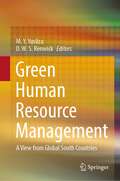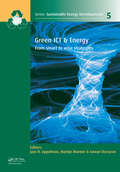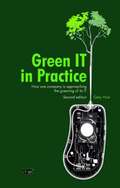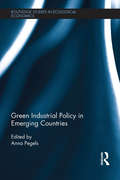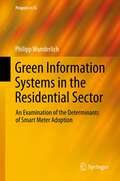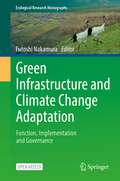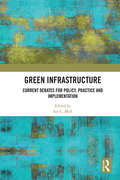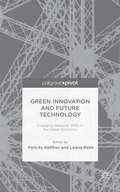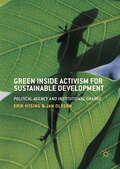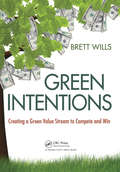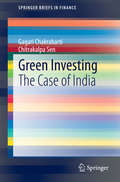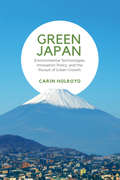- Table View
- List View
Green Human Resource Management: A View from Global South Countries
by M. Y. Yusliza D. W. S. RenwickThis book offers a fresh perspective on Green Human Resource Management (Green HRM) by focusing on the Global South's industries and cultures. It takes a scientific approach, using evidence to show how sustainable practices in HR can promote environmental goals. The book contributes significantly to the understanding of both the theory and real-world impact of Green HRM. The book offers a wealth of information on various approaches making it not only an intriguing read but also an informative and insightful reference for Green HRM experts all over the world.
Green Hydrogen in Chile
by Tarun Khanna Mariana Cal Jenyfeer Martinez BuitragoIn 2020, the Chilean government wants to promote green hydrogen, a technology with high potential to help mitigate climate change. President Sebasti n Pi era, aware of the country's advantages to produce green hydrogen competitively, asks Energy Minister Juan Carlos Jobet to elaborate a mission-oriented strategy to promote the technology. The strategy was to match the government's center-right orientation and the country's political and economic trajectory. Chile was often praised for its strong macroeconomic fundamentals and a sound policy framework. However, the country was facing social and economic disruptions given the Covid-19 pandemic, which added pressure to an already difficult political backdrop. Chile still struggled with unprecedented political uncertainty after social unrest in 2019 led to a wave of protests that forced the government to agree to a constitutional reform and greater social spending.
Green ICT & Energy: From Smart to Wise Strategies
by Anwar Osseyran Martijn Warnier Jaco H. AppelmanThis book provides the connection between the growing body of literature on sustainability and the topics of energy and ICT. It aims to show how stakeholders active in this area need to play their part ensuring that the ICT-sector evolves towards a sector that can lead throughgreening by IT and also shows that it cangreen its own IT as well.
Green IT
by Rüdiger Zarnekow Lutz KolbeDie zunehmende Verbreitung und steigende Abhängigkeit von Informationstechnologien und darauf aufsetzender Dienste führen zu bisher unberücksichtigten ökologischen und sozialen Herausforderungen. Das IT-Management sieht sich aufgrund dieser Entwicklung mit neuen Anforderungen seitens der Geschäftsbereiche, der Kunden und der Mitarbeiter konfrontiert. Wachsender Energieverbrauch beim Betrieb und der Nutzung von IT-Infrastrukturen bei kontinuierlich steigenden Rechenleistungen sowie die immer kürzer werdenden Lebenszyklen von IT-Produkten erfordern neue strategische Konzepte für das IT-Management. Vor diesem Hintergrund werden in diesem Buch Best Practices im Bereich Green IT vorgestellt. Anhand von Fallstudien, die gemeinsam mit Autoren aus der Praxis verfasst wurden, sollen die Bedeutung und der Umsetzungsstand einer Nachhaltigkeitsorientierung im IT-Management aufgezeigt werden. In diesem Zusammenhang dokumentieren die Fallstudien aktuelle Bemühungen der Organisationen im Rahmen einer Green IT. Ziel des Buches ist es, IT-Organisationen anwendungsorientierte Konzepte und Modelle für die praktische Umsetzung zur Verfügung zu stellen.
Green IT Strategies and Applications: Using Environmental Intelligence (Advanced & Emerging Communications Technologies)
by Bhuvan UnhelkarBhuvan Unhelkar takes you on an all-encompassing voyage of environmental sustainability and Green IT. Sharing invaluable insights gained during two battle-tested decades in the information and communication technologies industry, he provides a comprehensive examination of the wide-ranging aspects of Green IT-from switching-off monitors, virtualizin
Green IT in Practice
by Gary HirdOrganisations are becoming increasingly concerned about climate change, and are looking for ways to reduce their environmental impact. A brand with a genuine commitment to the green agenda will be more valued by its customers, and cutting energy consumption means that your business can also cut costs. The IT department has a vital role to play in minimising the carbon footprint of your organisation. Green IT in Practice, Second edition provides guidance on how to implement a Green IT programme. It will help you to formulate a Green IT policy, curb demand for data storage capacity, and lower the electricity consumption of the datacentre. A specific chapter looks at how server and desktop virtualisation can enable your business to save energy and space. Based on his first-hand experience of successfully implementing Green IT initiatives for the John Lewis Partnership, the author describes the specific problems that JLP confronted, and explains the solutions that he found for them. He gives a fascinating account of how Green IT has enabled one of Britain's best-loved companies to make significant improvements in efficiency. This second edition has been updated to reflect the progress that JLP's Green IT programme has made since 2008. The author shows how IT can be harnessed to help reduce carbon emissions across the whole organisation, pointing to the success of IT initiatives at Waitrose in improving demand forecasting and reducing food miles.
Green Inc.: Guide to Business and the Environment
by Frances CairncrossFrances Cairncross, senior editor of The Economist and author of the best selling Costing the Earth, shows that economic growth does not have to be at the expense of environmental protection. For the poor, growth is essential, to eliminate the threats to health and environmental security that poverty presents. As for the more affluent, they may be unwilling to sacrifice their living standards, even for a cleaner environment. The question is, rather, how can the environmental impact of growth be minimized? Here, the role of business is crucial. New technologies and well-designed policies have to work hand in hand; and the interests of governments, of companies and of the environmental movement lie in making a cleaner environment an opportunity for profitability. All three parties will find this a stimulating survey and an invaluable practical guide.
Green Industrial Policy in Emerging Countries (Routledge Studies in Ecological Economics #34)
by Anna PegelsFor decades, governments have tried to foster industrial competitiveness and economic growth. Many instruments are known to work, and many lessons have been learned. However, humanity is increasingly feeling the effects of natural resource depletion. The rate of this depletion is deeply unsustainable, and it is – as of yet – inextricably linked to economic growth and development. To preserve acceptable living conditions for future generations, while at the same time creating these conditions for millions of poor in the first place, we must achieve a de-linking of economic activity and resource depletion. This book identifies the drivers and success factors of green industrial policy, which seeks to reconcile the synergies and trade-offs which exist between economic and environmental goals. Greening the economy is a goal which will require enormous investment. As markets are currently failing to provide the required incentives for environmental sustainability, governments must intervene and provide ‘policy rents’ for investments in sustainability while withdrawing rents from polluting investments. In this they will face the risk of political capture by interest groups and difficult choices among technologies. Rent management is therefore the heart of green industrial policy and the focus of this book. On top of this, the country examples provided in this volume focus on the emerging powers, which will have an important influence the future of our planet. However, the lessons learned are valuable not only for countries introducing green industrial policies for the first time, but also for those under pressure to reform existing policies. This book will be of interest to students, researchers and policymakers in the areas of energy policy, sustainable development, industrial economics and ecological economics.
Green Information Systems in the Residential Sector
by Philipp WunderlichGiven rising electricity consumption, coupled with finite resources, and a growing awareness surrounding sustainable energy, ICT-enabled electrical networks such as smart grids are increasingly being deployed by energy companies. One aspect of smart grids is smart meter technology (SMT), which are sophisticated digital electrical meters, having the potential to increase energy efficiency in both residential and industrial sectors. However, a challenge to SMT-implementation in residential settings has been its successful adoption by consumers. As many cases in the US, and other parts of the world highlight, such implementation projects have run into resistance from the consumers. Despite these challenges, little research has been conducted on this topic. This study is one of the first that attempts to fill that void by empirically examining the antecedents of SMT adoption amongst potential customers and a group of SMT users. Specifically, this study developed a model surrounding consumers' intention to adopt and use SMT, by drawing on theories of adoption and motivational psychology and also by including a set of context-specific variables.
Green Infrastructure Financing
by Jae Myong KohThis book explores the role of governments and international financial institutions (IFIs) in mitigating the perceived risks in green infrastructure markets of emerging and developing countries. Although green infrastructure is designed to enhance a country’s wealth, the author sheds light on the way that the market is failing to link up institutional investors’ needs for a stable yield with the demands of potentially financially-viable investments in green infrastructure markets. Providing a detailed analysis of the root cause of this market failure, this innovative book offers powerful solutions for developing countries. An essential read for academics of development economics and international finance, as well as practitioners and policy-makers, this book covers topics such as industrial policy, climate governance, carbon markets and capital markets.
Green Infrastructure and Climate Change Adaptation: Function, Implementation and Governance (Ecological Research Monographs)
by Futoshi NakamuraThis open access book introduces the function, implementation and governance of green infrastructure in Japan and other countries where lands are geologically fragile and climatologically susceptible to climate change. It proposes green infrastructure as an adaptation strategy for climate change and biodiversity conservation.In the face of climate change, dams, levees and floodways built as disaster prevention facilities do not sufficiently function against extraordinary events such as mega-floods and tsunami disasters. To prevent those disasters and loss of biodiversity in various ecosystems, we should shift from conventional hard measures to more adaptive strategies using various functions that natural and semi-natural ecosystems provide. Green infrastructure is an interconnected network of waterways, wetlands, woodlands, wildlife habitats and other natural areas that support native species, maintain natural ecological processes, sustain air and water resources and contribute to the health and quality of life for communities and people. Green infrastructure has mainly been discussed from adaptation strategy perspectives in cities and urban areas. However, to protect cities, which are generally situated at downstream lower elevations, we explore the preservation and restoration of forests at headwater basins and wetlands along rivers from a catchment perspective. In addition, the quantitative examination of flood risk, biodiversity, and social-economic benefits described in this book brings new perspectives to the discussion.The aim of this book is to accelerate the transformative changes from gray-based adaptation strategies to green- or hybrid-based strategies to adapt to climate change. The book provides essential information on the structure, function, and maintenance of green infrastructure for scientists, university students, government officers, and practitioners.
Green Infrastructure: Current Debates for Policy, Practice and Implementation
by Ian C. MellOur understandings of the landscapes around us are constantly changing. How we interact with, manage and value these spaces is important, as it helps us to ensure we live in attractive, functional and sustainable places. Green Infrastructure planning is the current ‘go-to’ approach in landscape planning that incorporates human-environmental interactions, understandings of ecology and how socio-cultural factors influence our use of parks, gardens and waterways. This book explores several interpretations of Green Infrastructure bringing together case studies of policy, practice, ecological change and community understandings of landscape. Focusing on how planning policy shapes our interactions with the landscape, as individuals and communities, the book discusses what works and what needs to be improved. It examines how environmental management can promote more sustainable approaches to landscape protection ensuring that water resources and ecological communities are not harmed by development. It also asks what the economic and community values of Green Infrastructure are to illustrate how different social, ecological and political factors influence how our landscapes are managed. The central message of the book focusses on the promotion of multi-functional nature within urban landscapes that helps people, the economy and the environment to meet the challenges of population, infrastructure and economic change. The chapters in this book were origianally published as a special issue in Landscape Research.
Green Innovation and Future Technology: Engaging Regional SMEs in the Green Economy
by Felicity Kelliher Leana ReinlThis book explores green innovation and future technology skill development within regional small to medium sized enterprises. Notwithstanding the goals of a greener Europe, there has been little debate as to how the skills required to fulfil the goals of sustainable development can be imparted within regions and within rural business communities.
Green Innovation in Central and Eastern Europe (Routledge Research in Sustainability and Business)
by Dagmara Lewicka Iryna Bashynska Svitlana Filyppova Olha ProkopenkoGreen Innovation in Central and Eastern Europe aims to explore the crucial role of green innovation in guiding organisations towards sustainable development amidst contemporary environmental challenges.It comprehensively examines the concept of the green economy, highlighting its essential features and its significance in promoting organisational sustainability. The study delves into the global state of green economy development, analysing trends in renewable energy, circular economy practices, and green technology innovations. Additionally, it investigates the role of international organisations in supporting the green economy and its impact on global trade and business opportunities. The monograph also addresses strategic planning processes that enable enterprises to integrate sustainability goals into their business strategies, with a focus on social and environmental aspects. It evaluates recycling as a central component of the circular economy, considering its economic and environmental impacts, and underscores the importance of green leadership in fostering a sustainable organisational culture through ethical decision-making and environmental considerations.The book will cater to a diverse audience, including professionals, researchers, policymakers, and business leaders committed to steering organisations towards sustainable development. It serves business executives and managers looking to integrate eco-conscious strategies within their organisations, researchers and academics in environmental science and business management, policymakers involved in crafting environmental policies, and environmental advocates seeking practical approaches to advance green initiatives. The content is particularly pertinent to professionals in the European Union and Central and Eastern European countries, with specific insights and case studies from Poland, Estonia, and Ukraine.
Green Innovation, Sustainable Development, and Circular Economy (Green Engineering and Technology)
by Nitin Kumar Singh, Siddhartha Pandey, Himanshu Sharma, and Sunkulp GoelAlthough green innovation and technology is not new, so far very limited information is available regarding the diversified approaches for green technologies and engineering. This book highlights the challenges and opportunities, offering a roadmap for using various approaches in the most cost effective way. The book discusses the interrelationship between a circular economy and green technologies. It presents the dimensions of green innovations and illustrates the challenges of industrialization, especially in terms of material synthesis and utilized processes. It covers the current environmental and health challenges of societies and describes the role of stakeholders in developing sustainable societies and industries. This book provides a line of approach to core and interdisciplinary students, academicians, research scientists, and various industry personnel to present their ideas of green innovations with a common vision of sustainable development of community and industries in mind. Features Discusses the interrelationship between a circular economy and green technologies Presents the dimensions of green innovations Illustrates the challenges of industrialization, especially in terms of material synthesis and utilized processes Covers the current environmental and health challenges of societies Offers the identification and role of stakeholders in the sustainable development of societies and industries
Green Inside Activism for Sustainable Development
by Jan Olsson Erik HysingThis book considers how public sector institutions can be transformed to better support sustainable development by exploring the concept of green inside activism and its importance for institutional change. The phenomenon of inside activism has been shown to be crucial for green policy change and this book focuses on public officials as green inside activists, committed to green values and engaged in social movement, acting strategically from inside public administration to change public policy and institutions in line with such value commitment. The book theorizes how green inside activism can contribute to a more sustainable development through institutional change. This theorizing builds on and relates to highly relevant theoretical arguments in the existing literature. The authors also consider the legitimacy of inside activism and how it can be reconciled with democratic ideals. This innovative work will appeal to students and scholars of public policy, political science and environmental politics.
Green Intentions: Creating a Green Value Stream to Compete and Win
by Brett WillsDeveloped by a plant manager who experienced first-hand the challenges to going green in a business environment, Green Intentions provides organizations with a simple, straightforward, and practical approach to green the Green Value Stream (GVS) process that is as mindful as it is profitable. Based on the highly successful, Lean philosophy, the GVS process shows you how to quickly identify, measure, and minimize the seven green wastes to realize immediate cost savings. With the initial savings from harvesting the low-hanging fruit, organizations will have the support and momentum needed to eliminate each of the green wastes, leading to environmental sustainability and the substantial business benefits that follow, including increased revenues, new customers, employee retention, innovation, and increased shareholder value.Part I, Going Green shows how the green value stream provides a dynamic, proven, and successful approach to going green. It also defines each of the seven green wastes, explains the overall green value stream process, provides guidance on implementing it in your organization, and shows how to map your green value stream.Part II, The Seven Green Wastes provides a step-by-step process for minimizing and eliminating each of the seven wastes. It includes real-life examples illustrating the environmental and economic benefits associated with moving toward the elimination of each.The book also includes: A Green Dictionary that defines current terms associated with the green movement Web links and other resources to help you in your journey toward environmental sustainability An environmental primer that clears through the rhetoric to give you a clear picture of what is going on with the environment and what the end goal of environmental and overall sustainability needs to look like
Green Internet of Things Sensor Networks: Applications, Communication Technologies, and Security Challenges
by Adamu Murtala Zungeru Joseph M. Chuma Caspar K. Lebekwe Pendukeni Phalaagae Jwaone GaboitaolelweThis book presents methods for advancing green IoT sensor networks and IoT devices. Three main methods presented are: a standalone system to support IoT devices that is informed by the amount of energy the solar array system can produce; a model of securing a building's main power supply against unauthorized use; and security of the IoT devices and their networks. For each, the authors outline the methods, presents security and privacy issues, and their solutions. The work suggests a layered approach to expose security issues and challenges at each layer of the IoT architecture and proposes techniques used to mitigate these challenges. Finally, perspectives are drawn and discussed for future directions in securing IoT sensor networks, covering evolving areas such as artificial intelligence, blockchain technology, sensor Internet of People, context-aware sensing, cloud infrastructure, security and privacy, and the Internet of Everything.
Green Investing
by Chitrakalpa Sen Gagari ChakrabartiThis book seeks to answer the essential question of the investment-worthiness of green instruments. It is evident that investing in green and energy-efficient firms will be the most profitable choice for wise investors in the years to come. The reconciliation of the social choice for green technology and investors' choice for gray technology will be automatically achieved once green firms become more profitable than gray ones, in the Indian context. As there has been very little research done in this area, especially in the Indian context, this book addresses that gap. In order to do so, it follows the development of five different portfolios consisting of 100% green, 75% green-25% gray, 50% green-50% gray, 25% green-75% gray and 100% gray stocks, and attempts to answer questions such as: Do green portfolios entail less relative own-risk as compared to their gray counterparts? How effectively do green portfolios avoid market risk? Are green portfolios inherently more stable? Do green portfolios have a higher probability of surviving a financial crisis? Is the performance of green portfolios backed by their fundamentals? Is there any particular technical trading strategy that can ensure a consistently above-average return from these portfolios?
Green Investing
by Jack UldrichIn Green Investing, Jack Uldrich profiles 100 of the world's leading green companies and offers readers a model portfolio for investing in clean, sustainable products.
Green Investing
by Jack UldrichYou can make money and be socially responsible. In Green Investing, Jack Uldrich profiles 100 of the world's leading green companies and offers readers a model portfolio for investing in clean, sustainable products. This book offers: Guidelines for smart investing; Long- and short-term trends in green investing; The bullish and bearish aspects of each investment; A sample portfolio of green stocks. If you want to save the planet and make money, Green Investing is the book for you.
Green Investing: A Guide to Making Money through Environment Friendly Stocks
by Jack UldrichA Simon & Schuster eBook. Simon & Schuster has a great book for every reader.
Green Investing: Changing Paradigms and Future Directions (Palgrave Studies in Impact Finance)
by Alessandro RizzelloThis book provides a unique picture of green finance by highlighting, under both theoretical and practical lenses, current changing paradigms and future directions in this field. The book is founded upon four major aspects that characterize current debates in green finance: products and services, financial innovation, green washing and transparency, and external pressures. The book is particularly useful to understand the current perimeter of the field; identify the potentials and challenges of the sector; explore current changing paradigms and its potentials to act as drivers for mainstreaming green finance; and conceptualize future directions of the field, with particular focus on its role in the post-COVID recovery plans. The book therefore is not only useful for deriving theoretical or practical implications for researchers and policy makers, but also to capture the evolving complexity of the field at the eve of extraordinary and green-driven changes in financial industry and in policy programs. The book also opens up interesting questions on theoretical advances in financial theory derived from these innovations and accelerated by the pandemic. It will be of interest to scholars and students from different academic disciplines such as economics, finance, political science, and entrepreneurship, as well as practitioners interested in green finance and in the financing of environmentally impactful organizations and projects.
Green Is Good: Save Money, Make Money, and Help Your Community Profit from Clean Energy
by Brian KeaneHere is a no-nonsense guide to how you, the average American, can easily make clean energy and energy efficiency part of your daily life, saving money, making money, and weaning your community off fossil fuels in the process. Energy guru Brian F. Keane walks you through the cost-benefit trade-offs of the exciting new technologies and introduces you to revolutionary clean-energy products on the horizon, making the ins and outs of renewable energy easily accessible. Featuring compelling, real-life stories that bring clean-energy problems and solutions from 30,000 feet to street level, Green Is Good walks you that last mile from awareness to adoption. It demonstrates how all of us can seize the opportunity and profit from it. Keane also discusses the challenges that clean energy faces, laying out time-tested strategies to overcome them. A renewable energy future isn’t just good for the environment; it’s good for the economy, and Green Is Good will show you how—before it’s too late.
Green Japan: Environmental Technologies, Innovation Policy, and the Pursuit of Green Growth
by Carin HolroydAs climate change continues to threaten both our economic and ecological well-being, countries around the world are trying to implement green strategies that will simultaneously curb emissions and spur economic growth. Green Japan critically examines the Japanese effort to combine economic growth with commitments to environmental sustainability. Carin Holroyd explores green growth strategies in various industries including conservation, energy, urban development, and international trade. Holroyd’s comprehensive analysis of how innovation strategies connect with environmental priorities combines a detailed study of government policies with insightful assessments of consumer and market responses. The unevenness of Japan’s success clearly demonstrates the exceptional technological innovation and creative public policy initiatives that are needed in order to successfully reverse the effects of climate change. Green Japan offers a nuanced and hopeful account of one nation’s attempts at linking environmental sustainability and continued prosperity.
